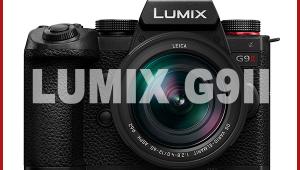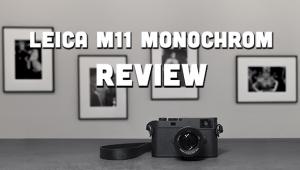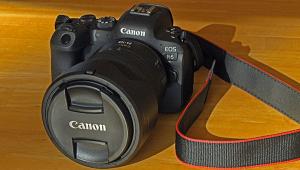Sony’s Alpha NEX-3 Compact System Camera; Interchangeable Lenses, Sweep Panorama & More Page 2
In hand, the feel of working with the camera is determined considerably by what lens you have mounted. With the 18-55mm zoom, the lens becomes an integral part of using the camera, and encourages, to me, a steadier shooting pose. The 16mm lens can also be operated that way but feels more like working with a typical point-and-shoot, the bonus being it allows you to carry the camera in your pocket. At first I could not fathom why the small knurled ring on the 16mm lens turned so easily, but then realized that you can set the camera up for AF/MF to fine-tune AF or go entirely manual focusing. In the latter case the center of the frame gets magnified when you make a slight turn on the lens focusing ring for extra-fine manual focusing control, a really nice touch.
The NEX-3 records on Sony’s own Memory Stick PRO (and PRO-HG) Duo and SD cards, including SDHC and SDXC formats. Processing is very fast in all modes, including Sweep Panorama, although there is no Raw, just JPEG, recording. As mentioned, when I opened the JPEG files I got about 40MB file sizes from the “standard” shots and about 42MB from the Sweep Panorama shots, rather amazing file sizes to me, although de rigueur these days.
The Sony lenses so far for this camera (there are three dedicated lenses, including an 18-200mm f/3.5-6.3 not sent with my test kit) all have Optical SteadyShot image stabilization built-in, to me a necessity with a camera of this size and shooting configuration. I must say that I found the images produced were quite steady even when working in quite low light and what I consider fairly chancy shutter speeds. As mentioned, you can adapt other Sony lenses (and older A-mount lenses sans AF) with an adapter.
 |
|
|
Now, about that Sweep Panorama. You might think that a camera with 14+ megapixels will yield a huge file size with the numerous shots it makes during the sweep, but the processing in the camera, which is quite swift, allowing you to shoot one “sweep” after the other in good succession, brings the file size to about 42MB, about what you’d expect in a single file from this megapixel count. That’s no small file, though, and at 300dpi you can push out a 6x27” print, and at 240dpi an almost 8x34” print, and goodness knows how large you can get with a reasonable resampling step.
The camera did a very good job of sharpness and steadiness when I did sweeps outdoors, choosing, on Auto ISO and Program mode, an ISO of 200 and a 1⁄160 sec shutter speed in almost all shots. Indoors, under museum lighting, when I did sweeps along gallery walls, the Auto ISO chose ISO 1000 and up (in one case ISO 1600) and a shutter speed of 1⁄60 sec. On magnification I have to say that the outdoors shots are sharper then the interiors, although that’s only apparent when you blow the interiors up considerably, and they are quite good, considering what kind of processing and shooting conditions you are demanding from the camera.
When you shoot a pan you have to be aware of the exposure and that there will be a problem if the scene goes from, say, shadows to bright areas and you start in the shadows with your pan. That’s why we always recommend that pans be done in Manual Exposure mode. The NEX-3 will of course allow you to shoot a pan that gets a lousy exposure as it will not adjust as you “sweep.” Just keep in mind that the exposure set when you first press the shutter release will be it for the rest of the pan. Also, if someone is moving through the frame you can get them “cut in half” with a stutter of motion recorded between two stitches. Some folks will force this effect just for fun.
In all, this is a very cool and fun, and fascinating, feature, but let’s face it, there are numerous cameras that will stitch for you during processing, albeit forcing you to take numerous shots and do the overlapping yourself. One thing—when you do a lot of pans you are definitely drawing on processor (and battery) power, so watch for the charge on the fuel gauge in the LCD.
 |
|
|
There was one other intriguing facet of the camera, discussed by Sony, supposedly available as a firmware upgrade by the time you read this report: 3D Sweep Panorama. This allows you to get 3D effects with one lens (it splits the sweep into left and right as it goes) that’s viewable on a compatible 3D TV. This report was filed prior to that feature being available and I seriously doubt that I will get a 3D TV, so for me the feature is fascinating but of mainly academic interest.
In all, the Sony Alpha NEX-3 combines lens interchangeability, a sensor larger than one might be used to in a camera this small, and a sleek interface to produce very good quality and sized images. Lack of a built-in flash, although an attachable one is supplied, might be considered a weakness by some, or, at the least, inconvenient. And if you demand AVCHD files rather than MP4 files, then choose the NEX-5.
This handy traveling companion might just be showing us the way for future digital cameras in the way the controls are handled and in the many features and functions it affords. It does raise some questions. Does a “serious” digital camera have to maintain the form factor of a 35mm SLR of old, or is it time to rethink the whole idea of what you can accomplish with a smaller body and sleeker interface? Does a small camera that holds a sensor similar in size to many D-SLRs challenge them as much in terms of image quality as it does in terms of portability?
 |
|
|
There’s no question that processing power will continue to narrow the gap and perhaps make the older form factors obsolete. Yet, despite the clever tricks and coming 3D capability, the NEX-3 asks you to give up some habits in the way you might be used to working. To me, the chief obstacle in cameras such as this is the lack of an eyepiece viewfinder system. Am I quite prepared to give up on an integrated optical finder and the intimacy and, in many cases, superior viewing it affords? Does the distance between my eye and the image I am composing matter? Does the shooting posture an LCD enforces make it less capable of yielding quality results?
In truth, if you’ve never shot with an SLR this is not something that will bother you. But, if you ever shot using a 4x5 with glass back and viewing cloth, shooting through an SLR viewfinder can be equally disappointing. That’s why when 35mm first appeared it was referred to as a miniature format, a form factor this new breed of camera challenges today.
To me it’s more a matter of a D-SLR vs. Compact System Camera (LCD-only composing and shooting) approach and how that affects quality, and that’s so subjective and individual I can’t make a judgment based on my shooting experiences alone. Indeed, some may find no quality difference despite how they have to compose and shoot while others may find it is a serious impediment. In other words, I am taking cameras like this seriously, perhaps thinking that we might be at the point where we turn the page on the old 35mm form factor.
 |
|
|
That’s precisely what a camera like this asks you to consider. If you give it a go, it will reward you with very good image quality and a newfound flexibility in how you work and lug around your gear. It might also open up some new tricks and photo ops you never considered possible. Whether the shooting poses it offers, and enforces, are your cup of tea is something only you can decide.
Firmware Update
As we went to press Sony announced a firmware update for the NEX-3 and NEX-5 cameras.
The camera firmware provides the following benefits:
1) Adds 3D Sweep Panorama function.
2) Improves the Sweep Panorama function by enhancing the accuracy of the stitching in cases where sky or sea occupy a large part of the scene.
3) Reduces power consumption when the camera is off.
4) Reduces start-up time under low-light conditions.
For more information, contact Sony Electronics Inc. at: www.sonystyle.com.
- Log in or register to post comments

















































